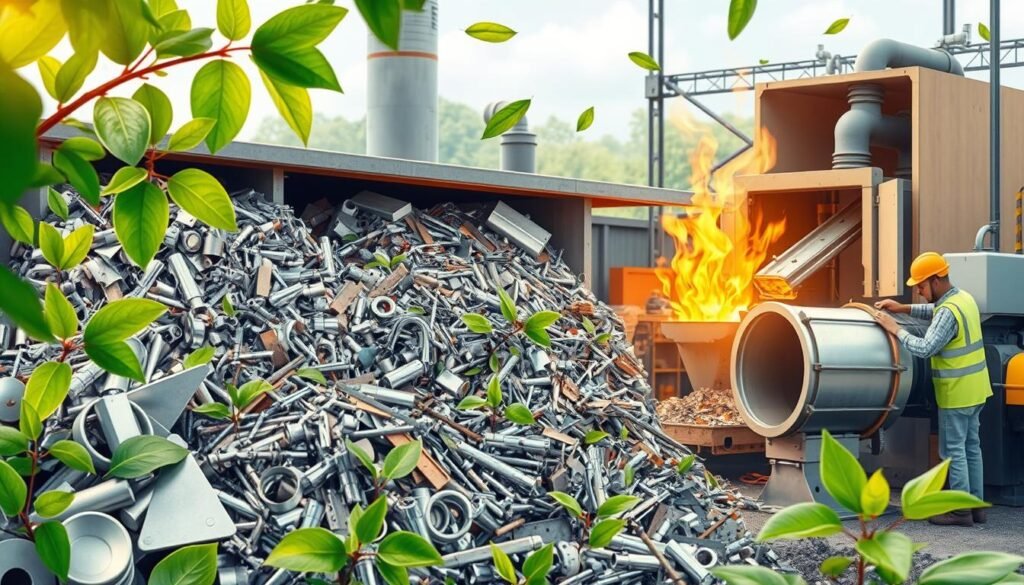من المهم للمهندسين والمصنعين والمصممين أن يعرفوا كيف يتفاعل الألمنيوم والفولاذ المقاوم للصدأ. هذه المعادن لها خصائص خاصة يمكن أن تتسبب في مشاكل عندما تلتقي بظروف معينة. هذا صحيح بشكل خاص عندما تتعرض لبيئات مختلفة.
عندما يتفاعل الألمنيوم والفولاذ المقاوم للصدأ، هناك خطر التآكل الجلفاني. هذه تحدي كبير في اختيار المواد وتصميم المنتجات. يحتاج الخبراء إلى فهم كيفية عمل هذه المعادن معًا لتجنب الفشل والحفاظ على عمل المكونات بشكل جيد مع مرور الوقت.
وقف التآكل هو المفتاح لإدارة كيفية تفاعل هذه المعادن. معرفة خصائصها الأساسية وكيفية تفاعلها يساعد الصناعات على إنشاء حلول قوية. بهذه الطريقة، يمكنهم جعل المواد تدوم لفترة أطول وتكون أكثر موثوقية.
النقاط الرئيسية
- تختلف تفاعلية المعدن بناءً على الظروف البيئية
- الصدأ الجلفاني يمكن أن يهدد سلامة المادة
- الاختيار الصحيح للمواد يمنع الفشل المحتمل
- العوامل البيئية تؤثر بشكل كبير على تفاعلات المعادن
- الوقاية الاستراتيجية من التآكل ضرورية للأداء على المدى الطويل
فهم خصائص الألمنيوم والفولاذ المقاوم للصدأ
المعادن ضرورية في الهندسة والتصميم اليوم. معرفة الألمنيوم والفولاذ المقاوم للصدأ تساعد في اختيار المواد المناسبة. كل معدن له خصائص خاصة تؤثر على أدائه في الاستخدامات المختلفة.
تركيبة الألمنيوم والفولاذ المقاوم للصدأ تؤثر على قوتهما ومدى أدائهما بشكل جيد. لننظر إلى ما يميز كل منهما.
التركيب الكيميائي للألمنيوم
الألمنيوم معدن خفيف ذو خصائص رائعة. عادةً ما يكون لديه:
- الألمنيوم النقي: محتوى الألمنيوم 99%
- سبائك الألمنيوم: مخلوطة بالنحاس، والمغنيسيوم، والسيليكون
- العدد الذري: 13
- الوزن الذري: 26.98
أنواع الفولاذ المقاوم للصدأ وخصائصها
الصلب المقاوم للصدأ يأتي بأنواع كثيرة، كل نوع لاستخدام معين. الأنواع الرئيسية هي:
- الفولاذ المقاوم للصدأ الأوستنيتي (الأكثر شيوعًا)
- الفولاذ المقاوم للصدأ الفريتيسي
- الفولاذ المقاوم للصدأ المارتينسيتي
- الفولاذ المقاوم للصدأ المزدوج
مقارنة خصائص المادة
| خاصية | ألمنيوم | الفولاذ المقاوم للصدأ |
|---|---|---|
| الكثافة | 2.7 جم/سم³ | 7.9 جم/سم³ |
| نقطة الانصهار | 660°C | 1400-1450°C |
| مقاومة التآكل | مرتفع | مرتفع جدًا |
| القدرة على التوصيل | طاقة كهربائية عالية | انخفاض كهربائي |
“فهم خصائص المعادن هو المفتاح للنجاح في الهندسة والتصميم” – مجلة علوم المواد
كل معدن له فوائده الخاصة، مما يجعله مثاليًا للاستخدامات المختلفة في الصناعة والأعمال.
هل يتفاعل الألمنيوم مع الفولاذ المقاوم للصدأ في بيئات مختلفة
تتغير تفاعلية المعدن بشكل كبير في أماكن مختلفة. كيف يتفاعل الألمنيوم والفولاذ المقاوم للصدأ معًا يعتمد على العديد من العوامل. تؤثر هذه العوامل على كيفية تآكلها وتصرفها كيميائيًا.
- مستويات الرطوبة
- نطاقات درجات الحرارة
- التعرض الكيميائي
- تركيز الملح
- تلوث الجو
“فهم الديناميات البيئية أمر حاسم للتنبؤ بتفاعلية المعادن,” يقول الدكتور مايكل رودريغيز، خبير علوم المواد.
البيئات البحرية صعبة على المعادن. الملح والرطوبة هناك يزيدان من تآكل الألمنيوم والفولاذ المقاوم للصدأ.
| البيئة | خطر التآكل | إمكانات التفاعل المعدني |
|---|---|---|
| الساحلي/البحري | مرتفع | رد فعل كبير |
| صناعي | معتدل | تفاعل شرطي |
| جاف/قاحل | منخفض | تفاعل منخفض |
أماكن الصناعة لها تفاعلات كيميائية معقدة. أشياء مثل درجة الحرارة، الرطوبة، والمواد الكيميائية تؤثر بشكل كبير على تفاعل الألمنيوم والفولاذ المقاوم للصدأ.
معرفة هذه العوامل البيئية تساعد المهندسين والمصممين على تجنب مشاكل تفاعل المعادن.
التآكل الجلفاني بين الألمنيوم والفولاذ المقاوم للصدأ
التآكل الجلفاني هو مشكلة خطيرة تحدث عندما تلامس معدنين في بيئة مالحة. يمكن أن يسبب مشاكل كبيرة، خاصة مع الألمنيوم والفولاذ المقاوم للصدأ.
عندما يلتقي الألمنيوم والفولاذ المقاوم للصدأ، يكون ذلك تحديًا كبيرًا للمهندسين. يجب عليهم إيجاد طرق لمنع المعدن من الفشل مبكرًا جدًا.
العملية الكهروكيميائية
عندما تلامس الألمنيوم والفولاذ المقاوم للصدأ، تبدأ تفاعل. يجعل هذا التفاعل معدنًا يتخلى عن الإلكترونات للآخر. من المهم إيقاف ذلك للحفاظ على قوة المعدن.
- الألمنيوم يعمل كالمعدن التضحيي
- الفولاذ المقاوم للصدأ يصبح الكاثود
- يحدث انتقال الإلكترونات من خلال وسط موصل
عوامل تؤثر على معدل التآكل
عدة أشياء يمكن أن تجعل التآكل يحدث بشكل أسرع:
| عامل | تأثير على التآكل |
|---|---|
| تركيز الإلكتروليت | تركيز أعلى يسرع التآكل |
| درجة الحرارة | زيادة درجة الحرارة تسرع التفاعل |
| مساحة سطح المعدن | زيادة مساحة الاتصال تزيد من خطر التآكل |
طرق الوقاية
لمنع تلف المعدن، يمكننا:
- استخدام الطلاءات الواقية
- تنفيذ العزل الكهربائي
- اختر تركيبات المعادن المتوافقة
- تطبيق الأنودات التضحية
فهم التآكل الجلفاني هو المفتاح لحماية الهياكل المعدنية وضمان المتانة على المدى الطويل. – خبير هندسة المواد
يحتاج الخبراء إلى التفكير في كيفية تفاعل الألمنيوم والفولاذ المقاوم للصدأ. هذا يساعدهم على وضع خطط حماية قوية.
تأثيرات درجة الحرارة على تفاعل المعدن
درجة الحرارة هي المفتاح في فهم كيفية تفاعل الألمنيوم والفولاذ المقاوم للصدأ. مع تغير درجة الحرارة، يتغير سلوك المعدن، مما يطرح تحديات في الهندسة وعلوم المواد.
تتغير المعادن كثيرًا عندما تتغير درجة الحرارة. التمدد الحراري هو عامل كبير في كيفية عمل الألمنيوم والفولاذ المقاوم للصدأ معًا. نظرًا لأن المعادن تتمدد وتتقلص بمعدلات مختلفة، فإن ذلك يمكن أن يسبب إجهاد وتآكل.
- الألمنيوم يتوسع حوالي 23.1 × 10^-6 لكل درجة مئوية
- الفولاذ المقاوم للصدأ يتوسع حوالي 17.3 × 10^-6 لكل درجة مئوية
- تغير معدل التمدد مع تركيبة السبيكة
فهم الديناميات الحرارية أمر حاسم للتنبؤ بأداء المعادن تحت ظروف قصوى. – معهد أبحاث هندسة المواد
تغيّر المعالجة الحرارية خصائص المعدن. المعادن يتحكمون في درجة الحرارة لتحسين خصائص المادة، مع تجنب التفاعلات الكيميائية الضارة والحفاظ على قوة الهياكل.
يمكن أن تؤدي درجات الحرارة العالية إلى التآكل، خاصة عندما تلامس الألمنيوم والفولاذ المقاوم للصدأ.
| نطاق درجة الحرارة | سلوك المعدن | المخاطر المحتملة |
|---|---|---|
| 20-100°C | تمدد عادي | تفاعل بسيط |
| 100-300°C | زيادة الإجهاد الحراري | خطر التآكل المحتمل |
| 300-500°C | تغييرات هيكلية كبيرة | احتمال تآكل عالي |
يجب على المهندسين والمصممين التفكير في تأثيرات درجة الحرارة هذه. عليهم منع فشل المواد وضمان استمرارية تجميعات المعادن لفترة طويلة.
التطبيقات الشائعة حيث يلتقي المعدنان
الألمنيوم والفولاذ المقاوم للصدأ أساسيان في العديد من المجالات. يُستخدمان في الصناعات والمنازل والمباني. خصائصهما الخاصة تجعلهما مثاليين للعديد من الاستخدامات، حيث يجمعان بين أفضل ميزات المعدنين.
الاستخدامات الصناعية للألمنيوم والفولاذ المقاوم للصدأ
هذه المعادن حاسمة في صناعة الأشياء. تُستخدم في:
- تصنيع معدات الفضاء
- آلات المعالجة الكيميائية
- أنظمة النقل المتقدمة
- مكونات الهندسة الدقيقة
تطبيقات المنتج المحلي
في المنزل، تُستخدم هذه المعادن لقوتها ومظهرها. توجد في:
- أجهزة المطبخ
- أواني الطهي والأدوات
- عناصر العمارة المنزلية
- مكونات الأجهزة الإلكترونية
أمثلة على صناعة البناء
في المبنى، هذه المعادن تساعد بشكل كبير. يتم استخدامها بطرق عديدة من قبل المهندسين والمعماريين.
| طلب البناء | المعدن الأساسي المستخدم | الفائدة الرئيسية |
|---|---|---|
| أنظمة الأسقف | ألمنيوم | خفيف الوزن، مقاوم للتآكل |
| الدعائم الهيكلية | الفولاذ المقاوم للصدأ | قوة عالية، متانة |
| التكسية الخارجية | مُركب الألمنيوم والفولاذ المقاوم للصدأ | الجاذبية الجمالية، مقاومة الطقس |
"التآزر بين الألمنيوم والفولاذ المقاوم للصدأ يستمر في دفع الابتكار عبر صناعات متعددة." – مجلة هندسة المواد
معرفة كيفية خلط هذه المعادن تساعد على صنع منتجات أفضل. فهي تؤدي إلى حلول أكثر كفاءة وقوة وإبداعًا في العديد من المجالات.
أفضل الممارسات لاستخدام الألمنيوم مع الفولاذ المقاوم للصدأ
للحصول على أفضل النتائج، من المهم اختيار المواد المناسبة واتباع قواعد التصميم عند خلط الألمنيوم والفولاذ المقاوم للصدأ. يحتاج المهندسون والمصممون إلى معرفة الخطوات الأساسية لتجنب التآكل والتأكد من أن الأمور تدوم لفترة طويلة.

- تقليل الاتصال المباشر بين الألمنيوم والفولاذ المقاوم للصدأ
- تنفيذ طبقات الحاجز الوقائية
- اختيار تقنيات الانضمام المناسبة
- فهم التفاعلات الكهروكيميائية
"الاختيار الصحيح للمواد هو حجر الزاوية في منع التآكل الجلفاني بين المعادن غير المتشابهة." – معهد هندسة المواد
تصميم لتوافق المعدن يتطلب عدة استراتيجيات ذكية:
- استخدام العزل الكهربائي بين المعادن
- تطبيق الطلاءات الواقية المتخصصة
- اختر المثبتات والموصلات المتوافقة
- السيطرة على التعرض للبيئة
| تقنية | الفعالية | تطبيق |
|---|---|---|
| طبقة الحاجز | مرتفع | الفضاء، البحرية |
| الأنودات التضحية | متوسط | الهياكل البحرية |
| عزل كهربائي | مرتفع | معدات صناعية |
باتباع هذه الممارسات الأفضل، يمكنك ضمان أداء موثوق وتمديد عمر التج assemblies المعدنية في العديد من مجالات الهندسة.
إجراءات وقائية وتقنيات الوقاية
الحفاظ على أجزاء المعدن من التآكل يتطلب خططًا ذكية. يجب على المهندسين والصناع أن يعرفوا كيف يحمي المعدن بشكل جيد. هذا يساعد على بقاء المعدات لفترة أطول وتعمل بشكل أفضل.
الوقاية الجيدة تعني استخدام العديد من طبقات الحماية. هذا ينطبق بشكل خاص على الألمنيوم والفولاذ المقاوم للصدأ.
خيارات الطلاء المتقدمة
الطلاءات المعدنية مهمة في إيقاف التفاعلات الكيميائية. تشمل طرق الطلاء المهمة:
- طبقات حماية تعتمد على الإيبوكسي
- أنظمة الطلاء الغنية بالزنك
- طلاءات الرش الحراري الخزفية
- تقنيات الطلاء بالمسحوق
تقنيات التثبيت الدقيقة
طرق التركيب الصحيحة تقلل من مخاطر التآكل. تشمل الخطوات المهمة:
- تنفيذ حواجز العزل الكهربائي
- استخدام حشوات غير موصلة
- اختيار مواد التثبيت المتوافقة
- الحفاظ على تجهيز السطح بشكل متسق
"الهندسة الوقائية دائمًا أكثر فعالية من حيث التكلفة من الصيانة التفاعلية" – مبدأ علوم المواد
اختيار خطط الحماية المناسبة يتطلب معرفة تفاعلات المواد والبيئات. يقول الخبراء إن إجراء فحوصات دقيقة قبل بدء أي حماية هو المفتاح.
الأثر البيئي لتفاعلات المعادن

تفاعلات المعادن بين الألمنيوم والفولاذ المقاوم للصدأ تثير مخاوف بيئية كبيرة. الأمر لا يقتصر على كيفية تفاعل هذه المعادن معًا فحسب، بل يشمل أيضًا كيف تؤثر على كوكبنا.
هناك العديد من القضايا البيئية المتعلقة بتفاعلات المعادن:
- عمليات التحلل الكيميائي المحتملة
- استهلاك الطاقة أثناء إنتاج المعادن
- توليد النفايات من تآكل المعدن
- تعقيد إعادة التدوير
إدارة المعادن المستدامة ليست خيارًا فحسب، بل ضرورة للحفاظ على البيئة. – معهد أبحاث المواد الصناعية
إعادة تدوير المعادن هي المفتاح لتقليل الضرر البيئي. المعالجة الصديقة للبيئة للمعادن تقلل من انبعاثات الكربون وتوفر الموارد. طرق إعادة التدوير الجديدة تحول النفايات إلى مواد قيمة.
إليك بعض الطرق لتحسين تفاعلات المعدن:
- تقنيات الطلاء المتقدمة
- تصنيع دقيق
- برامج إعادة التدوير للاقتصاد الدائري
- أنظمة إدارة التآكل التنبئية
علم المواد والعناية بالبيئة يسيران جنبًا إلى جنب. من خلال دراسة كيفية تفاعل الألمنيوم والفولاذ المقاوم للصدأ، يمكننا اتخاذ خيارات أفضل وأكثر صداقة للبيئة.
الخاتمة
فهم كيفية تفاعل الألمنيوم والفولاذ المقاوم للصدأ هو المفتاح للعديد من المهنيين. هذه المعرفة ضرورية للمهندسين والمصممين والمصنعين في مختلف المجالات. يظهر ملخصنا الديناميات المعقدة بين هذين المادة، مشيرًا إلى التحديات والفرص على حد سواء.
تظهر نتائجنا أن الألمنيوم والفولاذ المقاوم للصدأ يمكن أن يعملوا معًا، ولكن يتطلب الأمر تخطيطًا دقيقًا. يجب أن نركز على طرق حماية جديدة، وطلاءات متقدمة، وتركيب دقيق. سيساعد ذلك في تقليل مخاطر التآكل بين هذين المعدنين.
هذه الدراسة لها تداعيات كبيرة على العديد من الصناعات. فهي تساعد المهنيين في الفضاء، والبناء، والهندسة البحرية، وتصميم السيارات على تطوير أنظمة أفضل. من خلال استخدام استراتيجيات الوقاية الصحيحة، يمكن للمعدات أن تدوم لفترة أطول وتعمل بشكل أفضل في ظروف مختلفة.
مع استمرار تطور التكنولوجيا، أصبح دراسة توافق المعادن أكثر أهمية من أي وقت مضى. يحتاج المهندسون والعلماء إلى الاستمرار في إيجاد طرق جديدة للتعامل مع تفاعلات المعادن. هذا سيؤدي إلى اكتشافات جديدة في علم المواد ويساعدنا على فهم المزيد عن المعادن.
